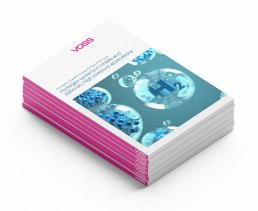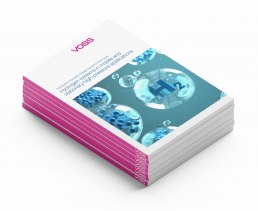Hydrogen: Application in the plant engineering
The Hannover Fair has proven: Hydrogen is booming. An entire hall was dedicated to the topic, and not without reason. A wide variety of industries and companies are actively working with this environmentally friendly energy carrier. Hydrogen has long since ceased to be a simple buzzword and is already playing a major role in plant engineering, for example.
Hydrogen unlocks many avenues for sustainable mobility. In addition to zero-emission operation of heavy-duty vehicles in the automotive sector, hydrogen is also ideal as a means of propulsion for rail, air and marine transport. H2 also provides an ecological alternative for the increasingly diesel-powered mining and agricultural machinery. Wherever long ranges at high weights are required, fuel cells boast their strengths compared to battery-powered vehicles - including aircraft and marine vehicles. Among the many possible applications from the automotive to the chemical and food industries, its elementary role in plant engineering is particularly striking. This is because to be able to use hydrogen in its diverse applications, the value creation of H2 from generation to storage must first be ensured.
Green hydrogen through electrolysis
As a wide-ranging industry, plant engineering has many fields of application related to hydrogen. One of the most important is hydrogen production by means of electrolyzers. In contrast to the fuel cell, in which electrical energy is generated with the help of hydrogen and oxygen, in electrolysis water is broken down into its components comprising hydrogen and oxygen. In this process, the chemical reaction of an electrolyte is triggered using electrical current, so that electrical energy is converted into chemical energy during the process.
If the electricity used in electrolysis is generated from renewable energy sources such as wind or solar energy (photovoltaics), it is considered climate-neutral. Electrolysis thus enables the CO2-free production of "green" hydrogen. Accordingly, electrolysis systems are increasingly in demand.
However, to make hydrogen technology viable for the future, it is necessary to industrialize electrolysis technology and drive forward the development of manufacturing capacities. This topic is being tackled by research projects such as “H2Giga”, which addresses the series production of water electrolysis systems that are currently still predominantly manufactured by hand. The project takes a modern and efficient approach to series production that makes green hydrogen even more competitive. With this in mind, the process takes into account the recyclability and flexibility of the electrolyzers. As part of this, an innovation pool is intended to ensure the continuous optimization of the project so that the demand for hydrogen can continue to be optimally met in the future.
Challenges in the storage of hydrogen
The challenge of using H2 lies primarily in the storage and distribution options. There are several solutions for storage and subsequent utilization: Storage as a compressed gas or in a liquid state is the most common. Compressors are needed to make hydrogen in its gaseous form usable as an energy source in the first place. They increase the energy density of the fine gas with a high pressure of up to 1,000 bar.
Consequently, to store the green fuel as a gas, special tanks are needed that can withstand this pressure. The most common are pressure tanks. A distinction is made here between Types I and V. The classic steel or aluminum tank (Type I) is used for nominal pressures up to 300 bar. Lightweight pressure vessels (Types III and IV) up to 1000 bar have great potential. Of course, the entire system, including all transfer lines for refueling, must be absolutely leak-free, since H2 molecules are the smallest of the molecules and therefore very volatile. Liquid hydrogen, on the other hand, is transferred under low pressure in a gaseous state to a vacuum, where it is cooled down to -253 °C using a great deal of energy. In addition, hydrogen can also be stored in chemical combination with metal in a hybrid storage system. However, the metal hybrid storage method is much less common.
One thing is certain: A lot of work is still required to be able to exploit the full potential of hydrogen for plant engineering. The existing hydrogen economy and numerous projects such as the H2Giga project described above show that existing systems are not yet able to meet Germany's demand for hydrogen. The DWV - German Hydrogen and Fuel Cell Association - writes in its information letter "Hydrogen for a Sustainable Energy Economy" that the main issue is to demand higher expansion targets for renewable energies and electrolyzers from the German government and to implement them in the short term. Only by expanding the necessary production capacities and power generation facilities can electrolysis output in Germany be significantly increased - and consequently make it possible to achieve the ambitious climate targets.
Would you like to learn more about H2?
Our free Whitepaper „The World in transition: Hydrogen as energy carrier of the future. Hydrogen systems in mobile and stationary high-pressure applications.“ illustrates the many different potential applications for hydrogen, and discusses the current state of the art.

Hydrogen: Application in the automotive industry
A wide variety of industrial sectors have already recognized the value of hydrogen, and there is good reason why it is seen as the fuel of the future. With the growing interest, many companies are increasingly using the green energy carrier in their systems and new concepts and ideas for its use are continuously emerging. In this blog, we take a closer look at one of the most important areas of application for hydrogen: the automotive industry.
Anyone who deals with the topic of hydrogen quickly realizes the great variety of possible applications. More and more industries are exploiting the enormous potential and building on the current state of the art. The automotive industry in particular is looking for new drive options that can offer an environmentally friendly alternative to conventional combustion engines. While many immediately think of electric or hybrid cars when the topic of alternative drives for the automotive industry comes to mind, the use of sustainable energy opens up numerous other possibilities.
After all, commercial vehicles such as tractors, trucks, mobile machinery and industrial trucks also need to find a long-term solution with alternative drives - and this is where hydrogen comes into play. It can be processed into synthetic fuels for use in internal combustion engines. The challenge in this application is the high range required for heavily loaded vehicles. Since conventional electrical systems cannot meet the high energy consumption, hydrogen is the most future-proof energy carrier in this field.
One prime example of sophisticated drive concepts are the hybrid systems from AE Driven Solutions. Their clever concept combines the ambient fuel cell with a battery to provide a CO2-neutral drive with a range of up to 400 km. The system has a total of three operating points: Full load, Standby and Off. Consequently, it only needs to be optimized for a single operating point, which helps it save a large amount of compression energy. In addition, the amount of energy available from the fuel cell system depends primarily on the capacity of the tank. This means that vehicles with mobile refrigeration units can also be operated electrically. With a pure battery drive, on the other hand, the transport of perishable goods such as food or medicine is not feasible.
Leak-free hydrogen transport
In order to put the theoretical advantages of hydrogen into practice, high-density connection solutions are required. This is because hydrogen is the smallest molecule and accordingly sensitive to transport - especially in the high-pressure range. Since everything at VOSS Fluid revolves around future-proof applications, we naturally have a solution for this as well. Our approach is called VOSS Lok 40: A tube forming system in which the fitter uses a forming machine to form a sealing and retaining contour on the tube end. Combined with a matching valve system, VOSS Lok 40 plays to its strengths even further to create a high-density connection in hydrogen- and gas-based propulsion systems.
VOSS joined forces with HypTec GmbH in 2022 for this purpose. The company's high-pressure valve components are suitable for hydrogen applications and fluid gas transport. HypTec's long experience and high level of expertise in the field of valve technology help in designing the sophisticated components. In combination with VOSS Lok 40, this forms a leak-free overall system for the transport and storage of hydrogen in the high-pressure sector of up to 700 bar.
Would you like to find out what else hydrogen can do?
In our free whitepaper „The World in Transition: Energy Carriers of the Future. Hydrogen systems in mobile and stationary high-pressure applications“, we go into detail about the wide range of possible applications in the high-pressure sector and clarify general questions about hydrogen.

